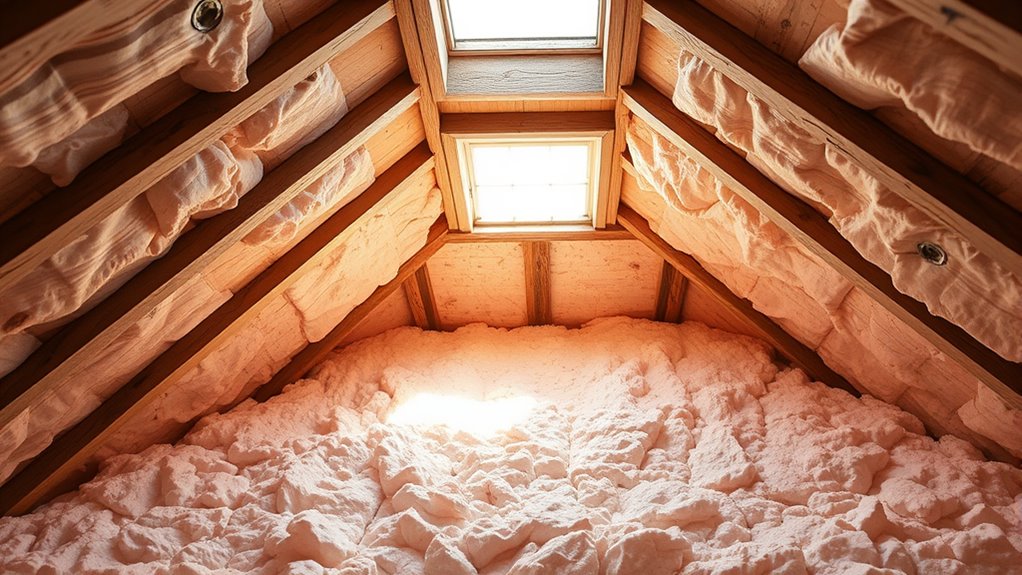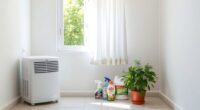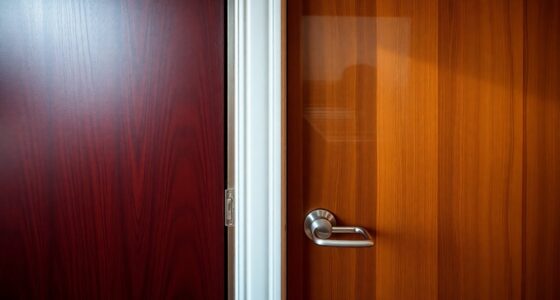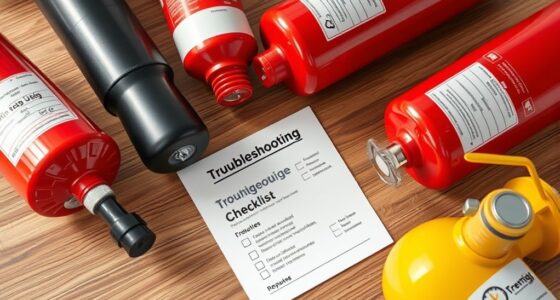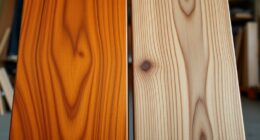Upgrading your insulation can greatly lower energy bills and boost comfort. Focus on adding attic insulation to keep heat in during winter and out during summer. Sealing and insulating ductwork ensures conditioned air reaches your home efficiently. Installing spray foam creates an airtight barrier, while new energy-efficient windows reduce heat transfer. Consider insulating basement and exterior walls for better temperature regulation. These improvements pay you back over time—discover how to maximize your home’s efficiency with more tips ahead.
Key Takeaways
- Upgrading attic insulation with proper R-values reduces heating and cooling costs, delivering long-term energy savings.
- Sealing and insulating ductwork minimizes air leaks, improving efficiency and lowering utility bills.
- Installing spray foam insulation creates airtight barriers that enhance energy efficiency and moisture resistance.
- Replacing old windows with energy-efficient models reduces heat transfer, decreasing energy costs.
- Combining reflective radiant barriers with traditional insulation maximizes thermal performance and savings.
Upgrading Attic Insulation for Maximum Efficiency

Upgrading your attic insulation can substantially boost your home’s energy efficiency and reduce heating and cooling costs. Proper roof insulation helps maintain consistent indoor temperatures by preventing heat loss in winter and heat gain in summer. Additionally, good attic ventilation works hand-in-hand with insulation, allowing excess heat and moisture to escape, which keeps your roof and attic components in better condition. When upgrading, verify your insulation material is thick enough to meet recommended R-values for your climate zone. Proper installation is key; gaps or compressed insulation can diminish effectiveness. Combining high-quality roof insulation with adequate attic ventilation creates a balanced system that optimizes energy savings. Ensuring your attic is properly ventilated is essential for sustainable living and long-term efficiency. You’ll notice lower utility bills and increased comfort, making this upgrade a smart investment.
Sealing and Insulating Ductwork to Reduce Energy Loss
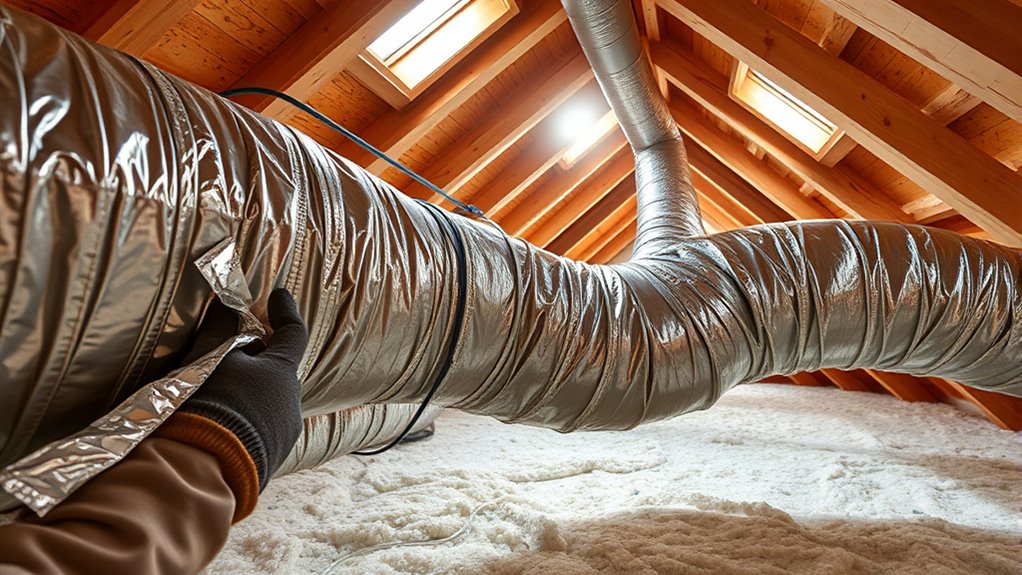
After improving your attic insulation, the next step is to address your ductwork, which can be a significant source of energy loss. Duct sealing is essential to prevent air leakage that wastes heated or cooled air and raises your energy bills. Start by inspecting visible duct sections for gaps or tears. Use mastic or foil tape to seal these leaks thoroughly. Don’t forget to check connections at joints and around vents. Properly sealed ducts ensure that conditioned air reaches your living spaces efficiently, reducing strain on your HVAC system. Insulating your ductwork also helps maintain temperature control and prevents energy loss. According to AI in Business, automation significantly streamlines reporting processes, saving time and resources. Taking these steps not only improves comfort but also delivers long-term savings by making your heating and cooling more effective.
Installing Spray Foam Insulation for Superior Air Barrier
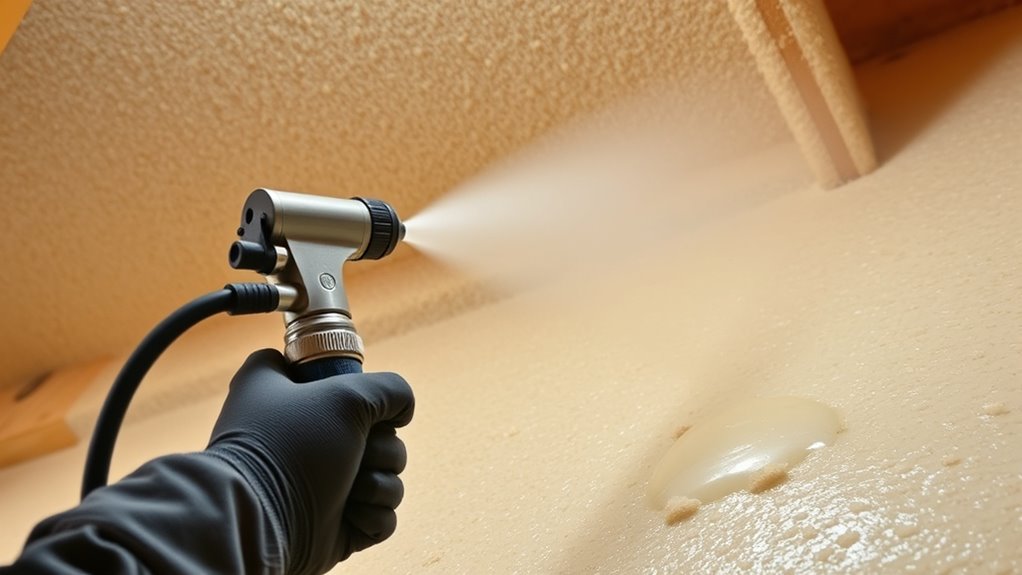
Installing spray foam insulation creates a seamless air sealant that blocks drafts and air leaks effectively. This improves your home’s energy efficiency and helps lower utility bills. Plus, it offers moisture and mold resistance, protecting your space long-term. Using the right applicator, such as an airless paint sprayer, can make the installation process quicker and more precise, ensuring optimal coverage and performance.
Seamless Air Sealant
Spray foam insulation creates a seamless air barrier by expanding to fill gaps and cracks, preventing air leaks that compromise energy efficiency. This expansion guarantees a tight seal around windows, doors, and wall penetrations, substantially reducing air leakage. By sealing even the smallest openings, spray foam stops drafts that can make your home uncomfortable and drive up heating and cooling costs. Unlike traditional insulation, it forms an integrated barrier that minimizes gaps and prevents air infiltration. This draft prevention keeps conditioned air inside and unconditioned air out, maintaining consistent indoor temperatures. With a seamless air seal, you’ll notice improved comfort and lower energy bills, making spray foam insulation a smart upgrade for homeowners seeking long-term savings and enhanced home performance.
Enhanced Energy Efficiency
Enhancing your home’s energy efficiency starts with creating a superior air barrier, and spray foam insulation is a proven solution. This insulation material expands upon application, filling gaps and cracks that other materials often miss. Its unique installation techniques guarantee a tight seal, reducing air leaks and drafts. Unlike traditional batt or blown-in insulation, spray foam provides both thermal resistance and an effective air barrier in one step. Proper installation is essential; professionals use specialized equipment to ensure even coverage and maximum adhesion. The result is a markedly improved energy performance, lowering your heating and cooling costs. Additionally, spray foam insulation can contribute to higher energy efficiency efficiencies, further reducing your reliance on heating and cooling systems. By choosing spray foam insulation, you invest in a high-quality insulation material that maximizes your home’s energy efficiency and comfort, paying dividends over time.
Moisture and Mold Resistance
Building a strong air barrier with spray foam insulation not only improves energy efficiency but also offers significant resistance to moisture and mold growth. By sealing gaps and cracks, spray foam helps with moisture control, preventing water from seeping into walls and ceilings. This reduces the risk of mold development, which thrives in damp environments. Its impermeable nature keeps humidity levels in check, creating a healthier indoor air quality. Unlike traditional insulation, spray foam resists mold spores and doesn’t decay or support mold growth itself. Installing spray foam is a proactive step toward mold prevention, especially in areas prone to moisture issues like basements and bathrooms. Proper installation and inspection are essential to ensure compliance with safety standards and regulations. Protect your home from hidden moisture problems and enjoy a safer, healthier living space with this effective insulation choice.
Replacing Old Windows With Energy-Efficient Models
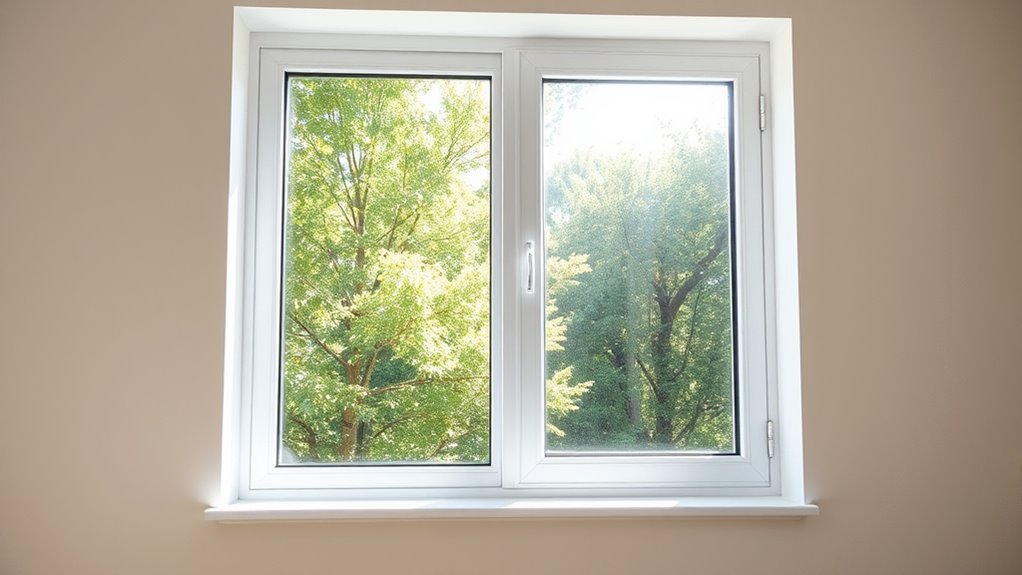
Replacing your old windows with energy-efficient models can considerably boost your home’s thermal performance, keeping it warmer in winter and cooler in summer. These upgrades also add value to your property, making it more attractive to future buyers. Ultimately, investing in new windows enhances comfort while reducing your energy bills. Additionally, choosing insulation upgrades can further improve your home’s energy efficiency and savings.
Improved Thermal Performance
Upgrading your old windows to energy-efficient models can substantially boost your home’s thermal performance. These new windows reduce thermal bridges that allow heat to escape, helping maintain consistent indoor temperatures. They typically have a higher insulation R value, which means better resistance to heat transfer. Improved windows minimize drafts and cold spots, making your home more comfortable year-round. To maximize benefits, look for features like multi-pane glass and low-emissivity coatings. Upgrading also helps prevent heat loss through the window frame, further enhancing thermal efficiency. Incorporating soundproofing features can additionally improve acoustic comfort in your living space.
Enhanced Home Value
Switching to energy-efficient windows can substantially boost your home’s market value. During a home appraisal, modern, high-performance windows stand out as a desirable upgrade, signaling energy savings and improved comfort. This enhancement not only attracts potential buyers but also increases your resale value. Homebuyers often prioritize updated features that reduce utility costs and boost aesthetic appeal, making energy-efficient windows a smart investment. Additionally, these windows can improve your home’s overall appeal and competitive edge in the real estate market. As a result, replacing old, inefficient windows can lead to higher offers and a quicker sale. Moreover, incorporating soulmate angel number insights can help you understand the importance of harmony and positive energy in creating an inviting space. Ultimately, this upgrade offers a tangible return by elevating your home’s value and making it more attractive to prospective buyers.
Insulating Basement Walls to Improve Overall Comfort

Have you ever noticed how cold and damp your basement feels during winter? Insulating your basement walls can boost your comfort and prevent issues like basement moisture and foundation instability. Proper insulation keeps cold air out and warmth in, making your basement more livable. It also acts as a barrier against moisture that can lead to mold or structural damage. To maximize benefits, consider:
Insulating basement walls enhances comfort, prevents moisture issues, and protects your foundation year-round.
- Sealing cracks and leaks before insulation
- Using foam board or spray foam for effective thermal resistance
- Adding a vapor barrier to prevent moisture transfer
Incorporating innovative materials can further improve insulation performance and sustainability. These upgrades enhance overall comfort, reduce energy costs, and protect your foundation. Insulating basement walls is a smart investment, paying off in lower bills and a healthier, more stable home environment.
Adding Insulation to Exterior Walls for Better Temperature Control
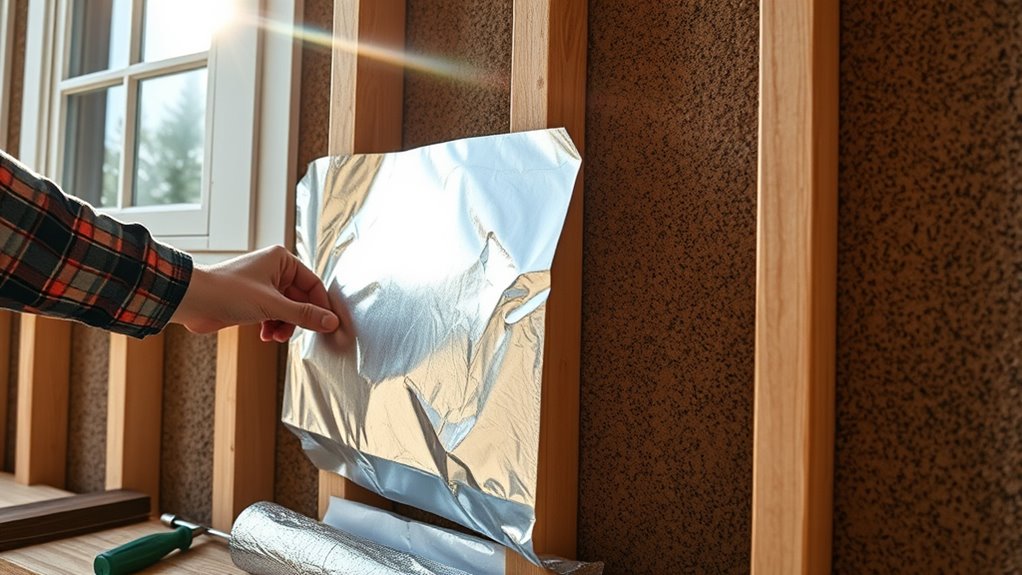
Adding insulation to your exterior walls is an effective way to enhance your home’s temperature control and energy efficiency. Exterior wall insulation helps maintain consistent indoor temperatures by reducing heat transfer through the walls. It also supports weatherproofing exterior surfaces, protecting your home from drafts, moisture, and temperature fluctuations. Installing exterior wall insulation can lower heating and cooling costs, making your home more comfortable year-round. It’s a smart upgrade that improves energy savings while adding an extra layer of protection against the elements. Properly insulated exterior walls not only boost your home’s efficiency but also prolong its lifespan by preventing moisture damage and reducing strain on your HVAC system. Overall, this upgrade pays you back through lower utility bills and increased comfort.
Utilizing Reflective and Radiant Barriers to Lower Cooling Costs
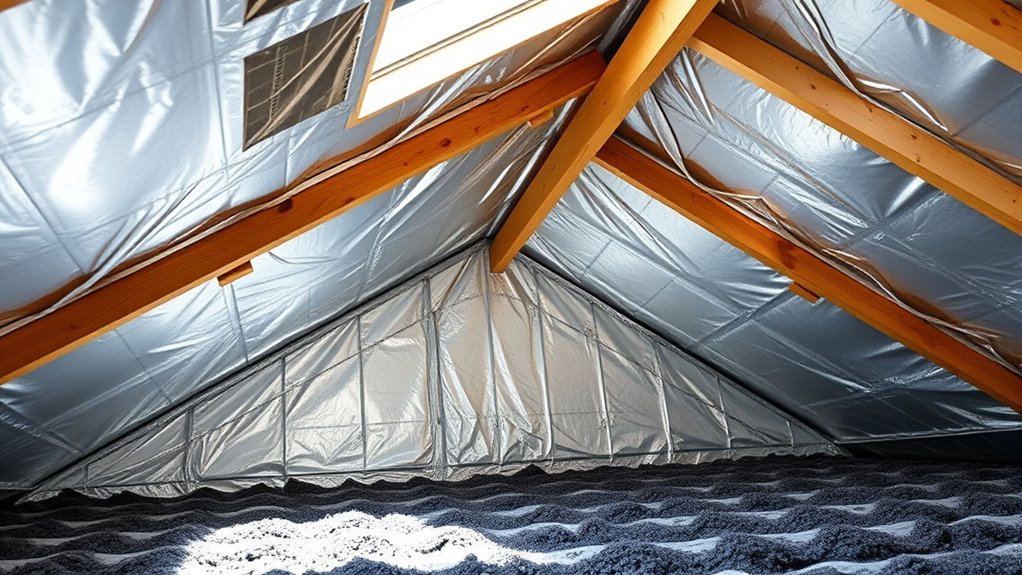
Utilizing reflective and radiant barriers is an effective way to reduce cooling costs by limiting heat transfer into your home. These barriers, like reflective barriers and radiant barriers, reflect heat away from your attic or roof, keeping your home cooler. Installing these barriers can substantially lower your air conditioning use and energy bills. To maximize their effectiveness, consider:
- Installing reflective barriers on the attic floor or roof deck
- Using radiant barriers in conjunction with traditional insulation
- Ensuring proper ventilation to prevent heat buildup
- Understanding how silly tantrums often occur during family photoshoots, adding humor to the process
Reflective barriers work by reflecting radiant heat, while radiant barriers specifically target heat transfer from the sun. Both options help keep indoor temperatures comfortable, reducing your cooling costs and making your home more energy-efficient.
Frequently Asked Questions
How Long Does Insulation Upgrade Installation Typically Take?
You might wonder about the installation timeline for an insulation upgrade. Typically, it takes a few hours to a day, depending on the area size. Your contractor will coordinate scheduling to minimize disruption. Larger projects, like whole-house insulation, may take longer, possibly a couple of days. Clear communication with your contractor guarantees the process fits your schedule, and you’ll have your upgraded insulation installed efficiently and quickly.
Are There Any Health Risks Associated With Spray Foam Insulation?
You might wonder about health concerns with spray foam insulation. While it’s effective, there’s potential for chemical exposure during installation, which could cause irritation or allergic reactions in some people. However, once cured, it’s generally safe. To minimize risks, guarantee proper ventilation during application and hire experienced professionals. If you have respiratory issues or sensitivities, discuss your concerns with the installer to ensure safe handling and curing.
What Is the Average Cost to Upgrade Attic Insulation?
Upgrading your attic insulation costs vary based on attic access and insulation materials used. On average, expect to spend between $1,500 and $3,500. If your attic has easy access, installation is quicker and cheaper. Different insulation materials like fiberglass, cellulose, or spray foam impact the price. Consider your attic’s size and existing insulation to get an accurate estimate, and always prioritize professional installation for best results.
Can Insulation Upgrades Qualify for Government Rebates or Incentives?
Imagine opening extra savings—yes, your insulation upgrades can qualify for government rebates and insulation incentives. Many programs are designed to encourage energy efficiency, so you might get financial help when upgrading your attic or wall insulation. Check with local and federal sources; these rebates could greatly cut your costs. Don’t miss out on this opportunity to make your home more energy-efficient while enjoying the benefits of government-supported incentives.
How Often Should Insulation Be Inspected or Replaced?
You should inspect your insulation at least once every 3 to 5 years to guarantee it’s performing well. The insulation lifespan varies depending on material, but most types last around 15 to 25 years. Regular inspections help spot issues like moisture, pests, or settling that can reduce efficiency. If you notice gaps or damage, consider replacing or upgrading your insulation to maintain energy efficiency and comfort in your home.
Conclusion
By exploring these insulation upgrades, you’re gently guiding your home toward greater comfort and efficiency. Think of it as giving your space a cozy, energy-saving hug that keeps everything just right without much fuss. With each improvement, you’re quietly turning your house into a more sustainable sanctuary—where savings and comfort naturally flourish. So, embrace these upgrades as a smart, subtle way to enjoy a warmer, more efficient home that rewards you in many quiet ways.
